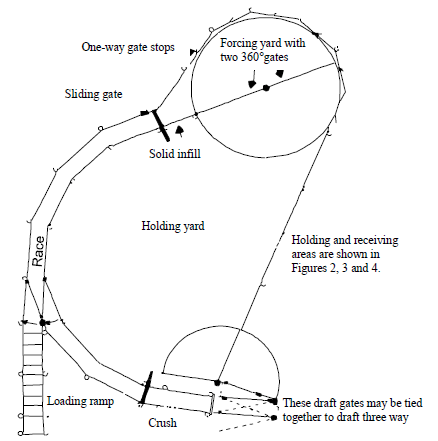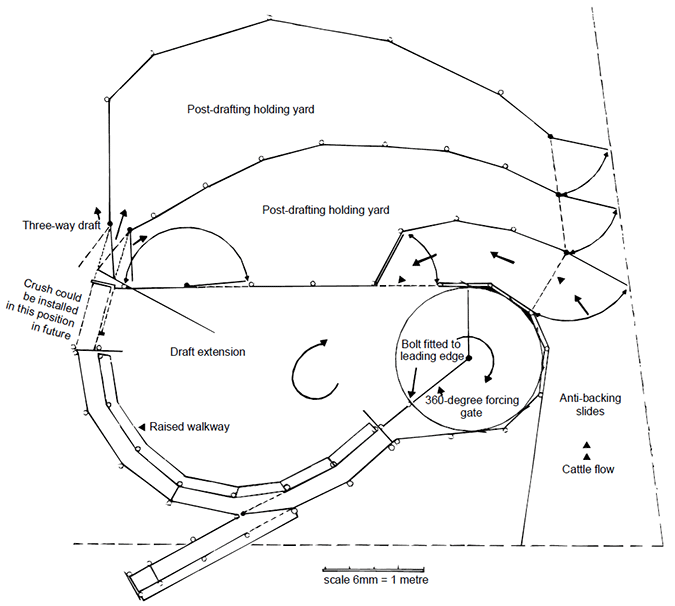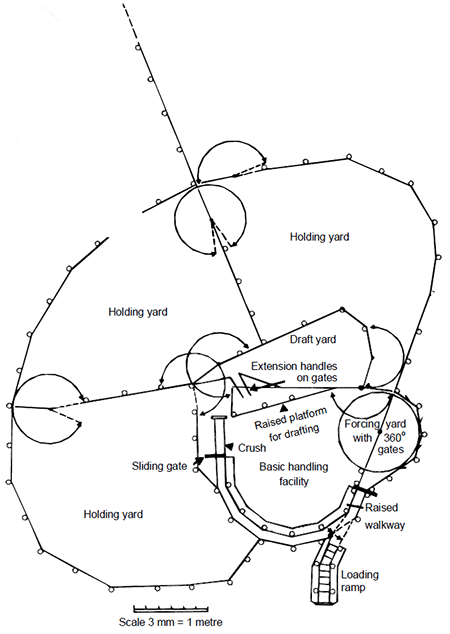Cattle handling facility 50 to 300 head
There are presently a lot of cattle yard designs based on a circular forcing yard. This is a proven layout that has good workability, and flow of cattle.
A good set of yards positively encourages sound management and herd health programs because of the ease of handling cattle. Where facilities are difficult to work, are in a poor state of repair, or do not exist — essential management practices are often not undertaken. The end result is often a lower price in the marketplace.
Where finance is a limiting factor, put the money into the working areas that affect your efficiency most — the race, forcing-yard and one strong holding yard. Additional capacity can always be added as needed or afforded later but it is difficult to alter these working areas.
Locate your yards after considering the following points:
- Arrange access to laneways and as many paddocks as possible.
- Keep yards away from living areas to minimise noise, flies, dust and smell.
- Allow for all-weather access of trucks to and from market. Remember, the best prices are often paid on wet days because many farmers cannot get their stock out.
- Water and power should be laid on or close at hand.
- Good drainage is essential. Build on a gravel rise if possible, or build up the site with gravel.
- Shade trees make working cattle more pleasant in summer.
Features of the handling facility

Figure 1
Holding yard
Cattle in yards will often bunch up with their heads in a corner. It is time-consuming and often dangerous to move cattle out of this situation.
The holding yard on the plan is circular-for this reason. The only corner where cattle may bunch up is in the direction where we want them to move to — the forcing yard.
Forcing yard
In many conventional yards the forcing yard is either too large or too small, has the wrong angle of approach to the race, and requires the operator to be in the yard to force cattle up the race. The forcing yard in this design is a half-circle, and there are no corners into which cattle can put their heads.
There are two gates swinging off a central pole which both swing through 360 degrees. This is an important point as you do not have to climb into the forcing yard to push cattle up the race. It may be done from behind the gate by pushing the gate at arm's length.
The use of the two 360-degree gates also allows the holding yard to be filled to capacity, which cannot be done where one forcing gate is used.
A further aid to safety of the operator behind this gate are one-way (non-return) catches in the centre of each forcing-yard panel. A spring loaded catch on the gate will ensure that the gate is positively held at these points.
The race
The curved race encourages steady movement of cattle around the race. This is in contrast to their movement in a straight race, in which cattle will often move very quickly forward, baulk and then move backwards. A curved race has a natural anti-backing effect, and tends to be self feeding when the inside panelling is open. Cattle will circle the operator in the round holding yard.
The height of the race panels should be 1.5 metres. The width between the posts should be 690mm plus the thickness of the rails.
A further aid to efficiency is to build a race of V section. The V-race does not allow cattle to turn and effectively controls animals of all sizes.
The loading ramp
The critical dimensions are:
- loading height of 1.2m
- width (between raise) is 750mm
- length is at least 3.5m if the ramp is to rise to a height of 1.2m.
In addition a level section at least 1 metre long at the top of the ramp will encourage easier stock movement. Cleats on the ramp floor will help the animals to keep their footing. However, a better way is to step the ramp in concrete. Allow a 450mm length of step for each 100mm rise.
Crush and head bail
For many operations with a beef enterprise, a headbail is sufficient. Commercial bails include parallel-sword walkthroughs and non walkthroughs (some swing open). The most efficient are full walkthroughs in which the animal can walk straight ahead after treatment, without first being backed out.
Also look for quietness, strength, safety for animal and operator, and positive operation from behind the animal.
Drafting
There are three ways of drafting cattle.
- Yard drafting, which usually requires 2 people. Remember to always draft cows from calves.
- Race drafting, which may be done by one person in this handling facility. For two-way drafting, the gate in front of the headbail can be operated with an extension bar. For three-way drafting, two gates facing the headbail are used and further holding areas shaped to suit.
- Laneneway drafting where cattle are released into a 2m wide laneway and drafted by a series of gates swinging across the laneway. These gates may be operated remotely by hydraulics or compressed air, for a single person operation.
Materials
It is important that the railing used is strong, quiet when knocked and presents a visual barrier to cattle. A pipe rail on the top inside of the race is useful.
The best posts are large-diameter pipe or lengths of railway rails. However, round timber posts are adequate if properly treated to prevent decay.
Mesh and cable should not be used in the race and forcing areas, especially if horned stock are to be handled.
Gates and catches
Gates should be tube-framed with the same infill as is used in the adjacent yard and race panelling.
Pipe sizes for use in various size gate frames are:
- vet's gates 25mm internal — diameter medium galvanised or black pipe
- up to 2.4m 32mm internal — diameter pipe
- 2.4m and wider 42mm internal — diameter pipe
Gates using timber infill should be braced from the top on the hinged side with 25mm by 3mm flat mild steel strap. A central vertical strap for gates wider than two metres is also desirable.
Catches should be positive bolt types, preferably spring-loaded. If chain and slot types are used, be careful.
Holding areas
Figures 2, 3 and 4 show various plans of holding areas attached to the same basic handling facility. The yard complex you choose may be one or a combination of these designs depending on the labour available to you and on your drafting and holding requirements.

Figure 2

Figure 3

Figure 4